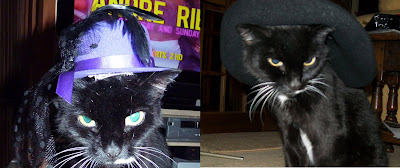
Remember me when I am gone away,
Gone far away into the silent land;
When you can no more hold me by the hand,
Nor I half turn to go, yet turning stay.
Remember me when no more day by day
You tell me of our future that you plann'd:
Only remember me; you understand
It will be late to counsel then or pray.
Yet if you should forget me for a while
And afterwards remember, do not grieve:
For if the darkness and corruption leave
A vestige of the thoughts that once I had,
Better by far you should forget and smile
Than that you should remember and be sad.
“Remember” by Christina Rossetti
Possibly coming from the legend that Baldwin III, Count of Ypres, threw some cats from a tower in AD962, their ability to fall from heights uninjured or associations with the cat-headed goddess of Egypt (Pasht or Bastet), the saying cats have nine lives is well known but sadly throughout my life has repeatedly been proven to be incorrect. Sure I have had several suicidal cats who seemed to like trying to dodge traffic or kept well away from the road until one sad day “curiosity [quite literally] killed the cat” but this week we lost another faithful friend who lived a very careful life.
Jenny had several homes. My mum first met her in an old people's home she used to work at. Jenny was then taken on by one of the ladies who worked there until her unfortunate death. A cat lover through and through, my mother took pity on Jenny and brought her home. For years I never thought much of her but as she grew in confidence she became quite the character – an unrelenting yowler, fine “lap cat” and strong lady who could hold her own. Constantly bullied by our two arrogant rather attractive male cats, she learnt to bat as well as she got and even managed to steal food from the boys. Suffering from thyroid problems, Jenny grew terribly thin and bony but always purred and had something to say. She spent most of her time sitting in the AGA cooker, on the DVD player or trying to steal the warmth from laptops and barely left the house, very occasionally stretching her legs outside the door for five minutes. Although recently, she'd become an extremely sociable “lap cat”, spending much of her time wherever anyone else sat.
About a month ago, we noticed a lump on Jenny's throat and after a visit to the vets our fears were confirmed. Jenny had cancer. It seems we have recently been rather unlucky with cats – we had one who contracted tuberculosis and currently have two with their own ailments – one suffered from some kind of appalling dermatitis causing him to rip away his fur and the other has finally recently been diagnosed with asthma having spent at least a year making strange noises you'd expect to hear from a guinea pig, duck or snake.
Jenny rapidly deteriorated in just under two weeks. The last time I saw her she was still animated - yowling and purring and I heard her more recently chatting away over the phone. Gravitating towards Dad, perhaps understanding the similar pain of his ailment, Jenny happily spent her last weeks. Sadly on Monday after obvious pain and apparently embarrassed by her ailment, Jenny departed. The world ration of births to deaths is stated on one website as five births to two deaths and elsewhere as 2.452:1 (worked out by using the global death rate: 8.23 deaths per 1000 population) and events this week are suggesting these dubious stats could actually be a true reflection of the world's life cycle: as one well-missed cat departs this earth, two friends have announced the end of life as they know it through the imminent births of “mini-thems”.
Farewell Jenny. It's quiet without you.




